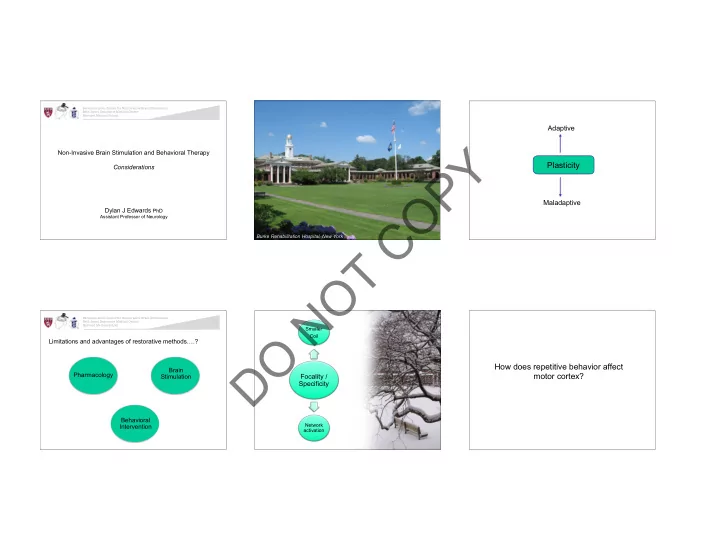

Berenson-Allen Center for Noninvasive Brain Stimulation Beth Israel Deaconess Medical Center Harvard Medical School Adaptive Y � Non-Invasive Brain Stimulation and Behavioral Therapy � Plasticity P Considerations � � O � � Maladaptive � Dylan J Edwards PhD C Assistant Professor of Neurology Burke Rehabilitation Hospital, New York T O N Berenson-Allen Center for Noninvasive Brain Stimulation Beth Israel Deaconess Medical Center Harvard Medical School Smaller O Coil Limitations and advantages of restorative methods … .? D How does repetitive behavior affect Brain Pharmacology motor cortex? Stimulation Focality / Specificity Behavioral Network Intervention activation
Y Motor map changes with skilled practice P O C Simple repetitive finger movements increase excitability T O N SICF SICF Berenson-Allen Center for Noninvasive Brain Stimulation Berenson-Allen Center for Noninvasive Brain Stimulation Beth Israel Deaconess Medical Center Beth Israel Deaconess Medical Center Harvard Medical School Harvard Medical School O D TMS 1.5 msec. Amplitude How does NIBS affect motor cortex? (% control) 300 250 200 I-waves 150 100 Periodicity ~ 1.5ms 50 1 1.5 2 2.5 3 3.5 4 4.5 5 Inter-stimulus Interval (ms) Ziemann et al, 1998 tDCS
Functional Improvements TMS correlates “An excited neuron tends to decrease its sRT/cRT Resting MT discharge to inactive neurons, and increase this discharge to any active neuron, and therefore to Takeuchi, ¡et ¡al, ¡2008 ¡ Y Yozbatiran ¡et ¡al, ¡2009 ¡ Pinch force acceleration form a route to it, whether there are intervening Transcallosal Inhibition Boggio ¡et ¡al, ¡2007 ¡ Malcom ¡et ¡al, ¡2007 ¡ neurons between the two or not. With repetition, Hummel ¡et ¡al, ¡2007 ¡ this tendency is prepotent in the formation of Fregni ¡et ¡al., ¡2006 ¡ fingers/thumb AROM neural routes”. Talelli ¡et ¡al., ¡2007 ¡ ¡ ¡ ¡Kim ¡ MEP Amplitude P Fregni ¡et ¡al., ¡2005 ¡ Movement accuracy et ¡al., ¡2006 ¡Hummel ¡et ¡ (Hebb, 1932, p.13). Mansur ¡et ¡al., ¡2005 ¡ al, ¡2006 ¡Khedr ¡et ¡al., ¡ Takeuchi ¡et ¡al., ¡2005 ¡ Purdue Pegboard 2005 ¡Hummel ¡et ¡al, ¡ O williamcalvin.com Boggio, ¡et ¡al., ¡2006 ¡ ¡ Donald Hebb 2005 ¡ ¡ JTT Werhahn, ¡et ¡al., ¡2003 ¡ Webster et al (2006) Webster et al (2006) C The Organisation of Behaviour: A Neuropsychological Theory. D.O. HEBB (1949) IMPROVED CORTICOMOTOR OUTPUT FROM IPSI-LESIONAL M1 IMPROVED CORTICOMOTOR OUTPUT FROM IPSI-LESIONAL M1 & IMPROVED MOTOR BEHAVIOUR & IMPROVED MOTOR BEHAVIOUR D Edwards T O N Rate-dependent TMS protocols Long-term potentiation Long-term potentiation O High-frequency Excitatory ~10Hz Pre-synaptic Pre-synaptic D Glu Glu REPETITIVE Na+ Na+ Ca++ Ca++ Low-frequency Excitatory Inhibitory ~1Hz Na+ Na+ Mg++ Mg++ NMDA NMDA AMPA AMPA 50Hz Post-synaptic Post-synaptic ↑ EPSP EPSP Dendritic spine Dendritic spine Ca++ CaM CaMKII Intermittent Excitatory 5Hz AMPA AMPA THETA BURST 2 sec 8 sec Excitatory Inhibitory Continuous Thickbroom (2007) Ex Brain Res. Thickbroom (2007) Ex Brain Res.
Altering cortical excitability before repetitive synaptic activity LTP/ LTD Long-term depression Y Glu How does combined intervention affect Ca++ motor cortex? P Mg++ NMDA AMPA C CaMKII O Ca++ CaM PP2B • 1mA 10mins tDCS N • rTMS at 5Hz 100stim train at AMT – decreases SICI, but not lasting change in excitability as tested by single pulse TMS C • Result= after effects of tDCS can generate opposite effects of rTMS or conversely can alter the after effects of tDCS Lang et al (2004) Thickbroom (2007) Ex Brain Res. T O N Motor systems example If … Berenson-Allen Center for Noninvasive Brain Stimulation Beth Israel Deaconess Medical Center Harvard Medical School O Motor Training = improvement in function ‘X’ and … D Is coupling NIBS with therapy good? tDCS = improvement in function ‘X’ does … Motor Training = improvement in function + 2X, X 2 , or 0?? tDCS Buch et al 2011, J Neurosci
Anodal tDCS combined with robotic motor training Berenson-Allen Center for Noninvasive Brain Stimulation Beth Israel Deaconess Medical Center Harvard Medical School Kinematic measures v clinical function Anodal tDCS combined with robotic motor training Y Movement ¡Speed ¡(peak, ¡mean) ¡ Movement ¡Smoothness ¡ Aim ¡ P Deviation ¡ Highest correlation with clinical function 1mV Group SICI Index Conditioned / uncond O MEP amplitude * p < 0.05 1 * 0.5 C Pre-tDCS Post-tDCS Post-Robot 0 Pre Post Post “Kinematic Robot-Based Evaluation Scales and Clinical Counterparts to Measure Upper tDCS tDCS Robot Edwards et al (2009) Limb Motor Performance in Patients With Chronic Stroke” (Bosecker et al, 2009) Edwards et al (2009) T O N NIH funded study 2012-2017 – tDCS and robotic motor training in stroke Upper ¡limb ¡robotics ¡at ¡Burke-‑Cornell, ¡New ¡York Edwards PI: R01 HD069776 O Combined tDCS-Robotic Training Study Design D Training Period EVAL. EVAL. EVAL. EVAL. EVAL. 3x / wk, 12 weeks, 36 sessions 1 hour shoulder/elbow/wrist robotic training tDCS or sham pre training (2 groups) 1 wk 1 wk 6 months CLINICAL, KINEMATIC, NEUROPHYSIOLOGY EVALUATION • 60 patients, Right hemiparesis • >6mnths post first ischemic stroke • Robotic protocol alternates S/E-wrist robot across sessions • tDCS 2mA, 35cm 2, 0.9% NaCl soaked sponges Prelim data for Nexstim NICHE Trial 2014 Robotics with brain stimulation in patients with motor dysfunction
Berenson-Allen Center for Noninvasive Brain Stimulation Berenson-Allen Center for Noninvasive Brain Stimulation Thank you Beth Israel Deaconess Medical Center Beth Israel Deaconess Medical Center Harvard Medical School Harvard Medical School Conclusions Y - Brain state influences the response to neuromodulation P - Homeostatic mechanisms may oppose further enhancement when interventions are combined Other cortical areas? O - Combined neuromodulation & behavioural therapy can be effective - The optimal circumstances require further C investigation D J Edwards T O N O D
Recommend
More recommend